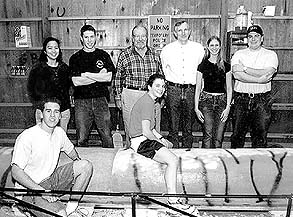A concrete what?
|
|
|
|
|
Canoe team: Jason Michener '03 (l), graduate student Wilasa Vichit-Vadakan, Evan Schwimmer '00, continuing education student Henry Callahan, Alicia Clermont '03 (on canoe), George Scherer, Ana Garcia '03 and Graham Elliot '01 (Photo by Denise Applewhite)
|
While some like to engage in extreme sportssky diving, ice climbing and the likeother Princeton students do what you might call "extreme engineering."
One group has designed, built and raced a canoe made of concrete. Another built a lightweight steel bridge and raced against the clock to erect it across a simulated 14-foot river without leaving the shore.
The feats were part of two annual contests sponsored by the American Society of Civil Engineers. The teams, which were the University's first representatives to the contests in many years, participated April 8 in a regional competition near Doylestown, Pa.
Although the Princeton teams' performances were modest compared to those of other schools that have refined their canoes and bridges for many years, students said the demands of competitive engineering were both fun and instructive.
"It's good general practice for considering real life problems and coming up with designed solutions," says senior Evan Schwimmer, who worked on both projects. "And it's a lot more fun than a problem set."
The students hope their initial efforts will develop into an annual tradition of entering the contests.
Floating concrete
A concrete canoe is a good way to spark interest in engineering among freshmen and sophomores, said Professor of Civil and Environmental Engineering George Scherer, who was the team's faculty adviser.
"The absurdity appeals to students," said Scherer.
"I love the reaction I get," agreed Schwimmer, who is president of the Princeton chapter of the American Society of Civil Engineers. "When I say I'm building a concrete canoe, they say 'A concrete what?'"
Schwimmer and junior Graham Elliot successfully pulled together a team that included members of all undergraduate classes, a graduate student and an 83-year-old continuing education student, who worked many evenings and weekends.
They received advice from people at the Hercules Cement Co. in Bethlehem, Pa., which also sponsored the project and paid for the materials and the trip to the competition. They also studied results from previous years' winners.
|
|
|
|
Juniors Rebecca Nixon (front)
and Deborah Kobes work on bridge (Photo by
Denise Applewhite)
|
|
"We can't wait until September to take another crack at it," said Elliot.
Speed bridge-building
While building a steel bridge seems more conventional than a concrete canoe, the bridge contest also offered many challenges. With strict rules governing the number of bridge elements and how they must be constructed, the group had to make a 14-foot span capable of holding 2,000 pounds, while making it light and fast to assemble.
With the help of civil engineering faculty adviser Jean Prevost and bridge expert David Billington, juniors Rebecca Nixon and Deborah Kobes designed the bridge on a computer. The two students quickly learned the importance of understanding not just principles of design but the realities of construction.
"Even if you come up with a perfect design," said Nixon, "it can't be a bridge unless you can build it on site."
After several failed or aborted practice runs, the team, with help from the canoe group, assembled the bridge successfully for the first time during the actual competition. Although the construction took more than an hour compared to the winner's six minutes, Nixon and Kobes were pleased.
"I think everyone is excited to come back next year and turn things around and do really well," said Nixon.
top

